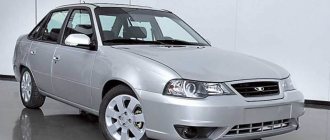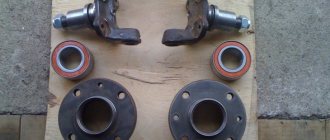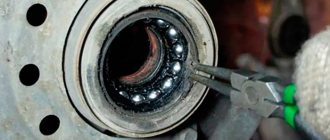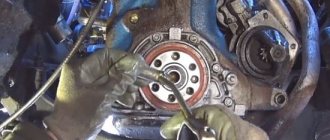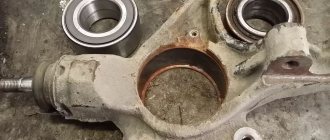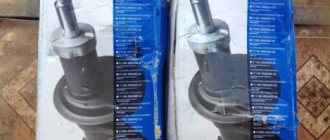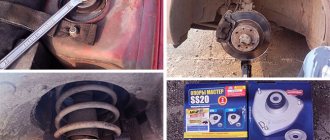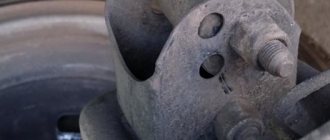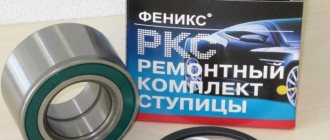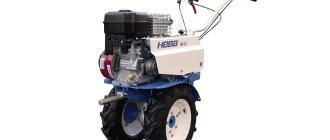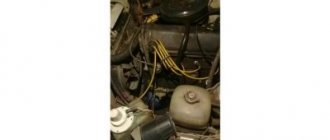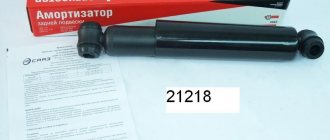Good afternoon. This is how our people are structured, that for some reason many of us are ashamed to admit that they don’t know something. Very often I come across the fact that the interlocutor says this ... "oh, yes, I’ve already done this a hundred times ... but how can I unscrew it." Well, what's shameful about that? Everyone is born almost the same...almost in equal conditions. And there is nothing bad that we don’t know something. It's bad when we don't try to learn something new.
I’ve been picking cars quite recently, soon it will be 10 years. And I started from absolute zero. My knowledge was really at the level of a blonde girl.
And I was also embarrassed to show my level of knowledge. And there was really no one to ask. And probably my main teacher was the Internet. Of course, the Internet is such a thing where any opinion must be questioned. It turns out that any information needs to be double-checked. That's not even the point. If there was information, everyone would choose the truth in it for themselves.
As for auto repair, everyone comes to this on their own. For some, knowledge is passed on by their father and they are already tinkering with their car out of inertia, for others it is their financial situation, for others it is their interest. At one time I also took my car to a service center... the most I did was change the air filter. And it seemed to me, oh, how complicated everything is, everyone should mind their own business... only professionals should get into a car, especially a Volvo. But it was the services that made me who I am...their JOBS. One jamb after another... and the last straw was that they didn’t tighten the steering rack when I replaced it. Each of you imagines what the consequences could be...
So, in a sense, I am very grateful to these craftsmen who forced me to take care of my car.
Why am I doing all this... this is to say that at some point, the Internet became the foundation of knowledge for me and I owe it to it. This is why I post here all the necessary and unnecessary photo reports. This is why this video post today will appear...even though I don’t like making videos.
This was a lyrical introduction, and as for the question... for those who will not watch the video, a small text description.
There is such a thing, the upper shock absorber support. Some kind of rubber-metal product. For clarity, I cut it in half.
Signs of shock absorber wear
There are several warning signs that can help you determine when your shock absorbers need replacing. For example: your car, after driving over railroad tracks, speed bumps, or dips in the road, continues to bounce after the fact.
Other signs include unusual noises over bumps, excessive body roll when cornering or when braking, where the front of the car dives forward sharply. Since shock absorbers wear out gradually, you can easily get used to such driving, just as you get used to a longer braking distance when the brake pads wear out.
How to determine shock absorber wear?
One way to check your shock absorbers is to press hard on each corner of your car. And if the car continues to bounce after you let go, then it's time to replace the shock absorbers. However, this test can be quite labor intensive and many SUVs or pickup trucks will not be able to test the shock absorbers this way.
Instead, you should have your shock absorbers inspected on a lift by a qualified mechanic. The mechanic will be able to see if there are any serious leaks (shock absorbers filled with fluid), if the mounts or bushings are worn, and if there is physical damage such as dents.
If you frequently drive on rough, uneven roads that put extra stress on your shock absorbers, you'll likely need to replace them more often than if you drive on a smooth freeway. Also, when transporting heavy loads, shock absorbers wear out faster.
How to check a support bearing
Hyundai Accent Logbook Replacing the front wheel bearing with a VAZ 2109 puller The myth has been dispelled into dust
Next, we will consider the question of how to determine a faulty support bearing with your own hands based on a characteristic sign. This is quite easy to do. To recognize how support bearings knock, there are three methods for checking the support bearing at home:
- It is necessary to remove the protective caps and press the upper element of the front strut rod with your fingers. After this, rock the car from side to side by the wing (first in the longitudinal and then in the transverse direction). If the bearing is faulty, you will hear a familiar knocking noise that you heard when driving a car on a rough road. In this case, the car body will sway, and the stand will either stand still or move with a smaller amplitude.
- Place your hand on the front shock spring coil and have someone sit behind the wheel and turn the steering wheel from side to side. If the bearing is worn out, you will hear a metallic knock and feel the recoil with your hand.
- You can focus on sound. Drive your car on uneven roads, including speed bumps. When there is a significant load on the suspension system (sharp turns, including at high speed, driving over bumps and holes, sudden braking), a metallic knocking sound of the support bearings will be heard from the front wheel arches. You will also feel that the car's handling has deteriorated.
Regardless of the condition of the support bearings, it is recommended to check their condition every 15...20 thousand kilometers.
Checking the “supporters” on VAZs
How do support bearings knock?
To extend the service life of a given bearing, very often, if the design allows it, mechanics wash and change the lubricant. If the part is partially or completely out of order, the support bearing is not repaired, but replaced. In this regard, a logical question arises - which support bearings are best to purchase and install?
Ford Mondeo support bearing repair
Detailed photo instructions on how to independently restore the performance of a Ford Mondeo support bearing. Do-it-yourself repair of the support bearing of the Ford Mondeo shock absorber strutRead more
Shock absorber (car shock absorbers)
The shock absorber ensures safety and comfort when driving by absorbing impacts, jolts, and vibrations of moving suspension elements.
Therefore, it is important to eliminate shock absorber problems in a timely manner - to maintain them correctly and change them in a timely manner. Read more.
Checking car shock absorbers
This video shows the consequences of faulty shock absorbers, and also describes popular testing methods: swaying, behavior on the road, what to look for during visual diagnosticsRead more
Signs of wear on the shock absorber strut mount
The main sign of wear on the shock absorber support is a dull impact on the car body when it hits a road bump. To visually verify its malfunction, open the hood and look at the shock absorber. If the rubber support is damaged or simply not in the right place, the support will have to be replaced.
If this is not done in time, then the shock absorber itself may fail along with the support. Therefore, do not delay replacing it for a long time to prevent damage to the car body.
Remember that at the same time as replacing the shock absorbers, the supports must also be replaced. Typically, you will pay almost the same for replacing shock absorbers along with the supports as for replacing the support separately.
Why do you have to replace the upper shock absorber mount?
Typically, the upper supports are relatively durable and do not need to be replaced frequently. But someday such a part will have to be replaced.
This usually happens for two reasons:
- As a rule, rubber is present in the shock absorber mounts and over time it wears out and becomes cracked. On the one hand, there is nothing serious about this, but in this state the support reduces the level of noise and vibration while the car is moving much worse.
- Failure of the upper support bearing. And this situation occurs much more often than damage to the rubber element. Moreover, the level of noise and irritation is much greater than from wear of rubber bands.
A sign of wear on the shock absorber strut bearings while driving can be identified by characteristic loud knocking noises, even when driving over slight uneven surfaces. This greatly irritates the driver’s nervous system and makes him want to quickly replace the support.
When do you need to replace support bearings?
The support bearing design is durable enough to last for years. But, given the quality of the surface on our roads, it often happens that they have to be changed almost every year.
According to the list of routine maintenance for the VAZ-2110, support bearings should be replaced after every 100 thousand kilometers. Well, if you determine that they have failed before the deadline, do not delay replacing them. The chassis, body, and control system elements will suffer from this.
Shock absorber strut support: wear, repair, replacement
It is difficult to imagine the suspension of modern cars without shock absorbers - specialized damping elements. They can be combined, gas or hydraulic. To ensure proper functioning of most components, two supports are required - at the top (body or frame) and at the bottom (axle beams, steering knuckle). Some shock absorbers are equipped with only upper mounts.
Some Tips for Replacing the Front Shock Absorber Upper Mount
- When disassembling, the hub nut should be loosened before you remove the wheel; if the car is already suspended on a jack, it will not be easy to move it.
- If you do not have a ball joint and tie rod remover, the steering tip can be knocked out by hitting the joint joint with a heavy hammer, the blows must be sharp and precise. Even if the tip seriously “boils” in the connection, after several attempts it will still come off.
- To make it more convenient to disassemble the shock absorber strut after removal, you can immediately (while the shock absorber is still on the car) loosen the shock absorber rod nut.
- To make the nuts and bolts easier to turn off during the next repair, it is recommended to treat the fasteners and threads with graphite lubricant during assembly.
- When removing the shock absorber assembly with the hub and steering knuckle, it is a good idea to check the condition of all suspension parts on this side of the wheel. Such diagnostics will save your money and time, because it is often discovered that along with a defective support bearing, for example, a shock absorber is also faulty, or the outer CV joint has a large amount of play.
- You need to compress the spring with ties gradually, squeezing the coils little by little on one side and the other. The spring is compressed until the upper support begins to rotate freely; too much compression of the coils is not required, and in general it is unsafe.
In general, replacing the support bearings on the front struts is quite simple; to make a replacement, you don’t have to go to a car service center; you can do the work yourself.
To avoid serious damage to car systems, you should pay attention to the slightest knock or creaking noise under the hood. If you stubbornly ignore seemingly minor signs of malfunction, then serious problems cannot be avoided. In particular, this is a knocking sound when turning the steering wheel. It may indicate a faulty front strut upper support bearing. Changing the support itself is quite simple, and this process will not be accompanied by serious costs. But if you do not pay attention to the breakdown in time, it will lead to more serious consequences.
The front strut support bearing is an important part of a car's suspension. Unfortunately, most drivers pay minimal attention to the health of their suspension systems. But in vain, given the state of domestic roads and, sometimes, the low quality of parts that are installed on modern cars. But it is the suspension that is responsible for car handling and road safety.
Its maintenance is complicated by the variety of parts, and they all perform their functions: brackets, springs, shock absorbers, and so on. In this article we will talk specifically about the support bearings of the front strut, since these parts are subject to increased wear and often fail.
Varieties
Parts, the installation of which is carried out with special eyes, are supplemented with silent blocks or rubber bushings necessary for connection with the body and suspension of the car. It is worth noting that the upper support of the shock absorber strut has become most widespread in passenger vehicles.
Based on the type of construction, supports are classified into two types:
The latter are made in the form of a single element made of metal and rubber and are most often used in the front suspension. The main part of the structure is the connection of a rubber cushion with an internal and external steel bowl. Fixation to the body is made by the outer casing, which has several holes for fasteners. The rod is installed in the central part, and in the upper part there is a device for limiting backlash, which is similar to a steel bowl.
Types of support bearings for VAZ-2110
There are four types of front strut support bearings:
- with built-in ring;
- with detachable inner ring;
- with detachable outer ring;
- single-divided.
The first type is characterized by the presence of special mounting holes. When using such parts, clamping flanges are not used. In addition, the support bearing of the front strut of the VAZ-2110 with a built-in ring is equipped with built-in gaskets that ensure constant and maximum rotation accuracy.
Designs with detachable inner and outer rings differ in the location of the latter. In the first case, the outer ring is in contact with the device body, in the second case, the inner ring is in contact. By and large, these bearings do not make much difference for a car like the VAZ-2110. But the fourth type of parts is characterized by the fact that its outer ring has a separation at one specific point, due to which the rigidity of the entire device increases significantly.
Installation options
There are two main types of stem mounting: through a bearing and using a sleeve. Bushings in budget options are made of aluminum and act as a sliding bearing. Expensive bearings use more complex bearings that have an angular contact design. The main purpose of the bearing is to ensure easy rotation of the shock absorber curtain. It is also worth noting the existence of parts with forced rotation of the rod.
The support of the shock absorber struts of a non-separable type can be equipped with a thicket to hold the spring or have a simplified design. In the latter version, the support bowl is fixed on a support or mounted on a rod. In another version, it is complemented by a rubber cushion with a recess for spring coils. Access to an installed support of this type is possible only from the wheel arch. This is due to the fact that the part most often experiences loads coming from below, and to ensure greater reliability, emphasis is needed on the body part. In this case, the bolts do not turn, since they are tightly connected to the outer casing. There are locking nuts in the trunk or under the hood.
What you need to replace a support bearing yourself
Before replacing the front strut support bearing yourself, make sure you have the following tools on hand:
- jack;
- wheel wrench;
- wrenches 9, 13, 19, 22;
- special puller for steering tips;
- tie for strut springs;
- pliers;
- marker, paint or core;
- “shoes” for fixing wheels or a pair of bricks;
- anti-rust liquid (WD-40 or similar).
What does a shock absorber strut support consist of?
The front or rear support, depending on the make of the car, is equipped with a plastic cap designed to prevent damage to the rod nut. It is fixed using latches or friction, located in the hole of the rebound limiter. The design of composite products is less complex, and most often they can be found in the rear suspension. They have three main parts: a steel spacer bushing, a lower and an upper rubber bushing. Also, the rear shock absorber strut support has an additional element in the form of a rubber compression buffer used to rest against the lower bushing.
The spacer rubber bushing is included in the design of the silent block installed in the hole in the body part. The rod is mounted in the support, the compression buffer is attached to the lower bushing using a washer, and the entire product is installed on the rod.
Replacement
Replacing the front support bearings is quite simple. The main thing is to find a really high-quality part, because not all manufacturers can provide supports with a high degree of wear resistance. So, we arm ourselves with the following tools:
- spanner;
- head for disassembling racks;
- spark plug head for ratchet;
- rod nut wrench;
- spring compressors.
And, of course, the prop himself. We will carry out the replacement procedure as follows:
- Jack up and remove the wheel.
- Remove the two nuts securing the front strut to the hub.
- Unscrew the nut from the shock absorber rod, while holding it with a hexagon.
- We remove the stand.
- Compress the spring and remove the support bearing.
- We again clamp the hexagon on the rod and unscrew the nut.
- We remove the bearing, install a new one and repeat all the steps, only in reverse order.
The cause of knocking while turning may be a malfunction of the steering rack, steering shaft or steering cardan. Therefore, after replacing the support, the problem may not disappear. In this case, all of the above systems should be checked.
Video on replacing the support:
Hello, dear friends! Let me call you exactly that. Today we have to discuss a fairly relevant topic for almost any car and its owner. We'll talk about the front strut support bearing.
Alas, the quality of our roads leaves much to be desired. Sometimes, when I travel outside the city center or into the suburbs, I am amazed at how anyone can drive there without visiting a service station every week.
The condition of the roads largely determines the need to change the support bearing quite often. The part is not the most expensive, but you will have to tinker with it if it fails.
Shock absorber strut support: possible damage
Many car owners are not aware of the existence of a part until it becomes unusable. Despite this, the quality of steering and suspension properties directly depend on it. Due to the reliability of the part, the comfort of driving the car increases, the correct functioning of the suspension is ensured and the resulting noise is reduced - all this is possible only in the absence of beating, vibrations and play, which are prevented by the support of the shock absorber struts.
Due to constant loads, the part gradually becomes unusable, the fit of the metal body to the rubber cushion deteriorates, as a result of which the quality of the suspension decreases and a dull knock occurs. The VAZ shock absorber loses its former functionality and contributes to the wear of other parts. Damage to steel bushings and bearings causes no less damage.
What is a support bearing and why is it needed?
Driveshaft Suspension Bearing
To understand what a support bearing is and what role it plays in a suspension, you need to understand how the suspension itself, in this case the front suspension, works. For example, the well-known “ten”, that is, uses an independent front suspension, which includes hydraulic struts and springs.
Causes of thrust bearing failure
If a vehicle's crankshaft is faulty or worn, it can put pressure on the crankshaft. The pressure affects the thrust bearing, forcing it in the opposite direction. This prevents proper load transfer. Dirt contamination can also cause bearing failure. Other causes include misalignment, poor crankshaft surface finish, and overload. When it comes to overdrive, it can be due to excessive torque converter pressure, clutch pedal drag, and a failed front HDD assembly.
The front struts, as you know, are necessary to dampen the vibrations that occur in the springs while the car is moving. The lower part of the rack is attached to the steering knuckle, and the upper part is attached to the car body.
Proper assembly of thrust bearings ensures that the tapered and supporting end surfaces are aligned. Tighten the main cap bolts and make sure the main cap faces the rear of the engine. Push the crankshaft forward into the block to ensure alignment. Tighten the main cover bolts while holding the crankshaft in this position. Finally, tighten the puff. Be sure to tighten the bolts to 10-15 feet.
Start your search by viewing any page for the search bar, then enter "thrust bearing" to get a list of available crankshafts. Those searching for this type of bearing may also search for "crankshaft part" or "crescent thrust bearing". Take a closer look at the item descriptions and photos to make sure the bearing is the correct one for your vehicle. Keep in mind the vehicle's dimensions and requirements to make the best choice.
It is considered to be part of the shock absorber; it is necessary for the movable connection of the shock absorber strut with the car body. The very name of this part - support bearing - already speaks of its intended purpose, that is, it is a kind of support for the front shock absorber strut. The “support” is located at the point where the pillar connects to the car body. In this location, the journal bearing is subjected to high axial loads, but thereby prevents failure of other more important and expensive parts, such as shock absorber struts.
The strut spring bearings are part of the spring damping system, acting as the interface between the spring strut and the vehicle body. As an important element of axle suspension design, they promote optimal contact between the tires and the road surface and increase comfort by isolating tire noise and road noise from the vehicle body.
They should also facilitate precise rotation of the spring on the front axle around the longitudinal axis. Where applications are concerned, a distinction is made between strut support bearings for the front axle and those for the rear axle. Because the requirements of these applications are not the same, the strut bearings for the front axle are designed and built differently for those for the rear axle.
Replacing supports
The algorithm for dismantling supports is approximately the same for all cars. First you need to unscrew the lower mounting point and remove the nuts securing the part to the body. The coils of the spring are compressed by a special coupler, which allows the support to be released. All that remains is to remove the stem nut. The new upper shock absorber strut mount is installed by performing all the steps in reverse order.
The parts do not require special maintenance and work for a long time. Despite this, it is necessary to periodically check their condition to ensure safe operation and increase the service life of the vehicle's chassis.
This is interesting: Bumper damage, types of repair work
How to determine if a support bearing is faulty
It is very simple to determine the malfunction of the OP. You need to open the hood, grab the shock absorber strut with your hand where it is attached to the body and swing it sharply from side to side. If there is play in the bearing or it has crumbled, the strut will move with characteristic clicks. You can do the opposite - grab the wing and rock the car sideways. Then, if the OP is faulty, the body will move, but the stand will remain almost motionless. All movements must be accompanied by knocking in the area of the defect.
Symptoms of a Defective Dome Bearing
Therefore, it is all the more important to be able to recognize symptoms that occur differently. If, for example, the steering in the cabin is audibly cracked, crunching and bending when tapped, the first sign is a broken, knocked out or even broken dome bearing
This type of noise can also be seen when entering and exiting a vehicle or when loading and unloading. Even more clearly, the defect occurs in the strut or dome bearing when the vehicle is driven over ground shafts, edges, or through the breeches.
Replacing the support bearing
To replace the OP you will need a jack, automotive tools and spring ties. Disassembly order:
- Loosen the wheel nuts.
- We put a jack and lift the car with a jack (you need to be on the safe side - put jack stands under the rear wheel)
- We remove the wheel.
- We disconnect the brake caliper and move it to the side; there is no need to disconnect the brake hose.
- We release the steering knuckle from the bottom from the lever and stabilizer bar.
- We unscrew the fastening of the shock absorber strut to the side member from above and remove the shock absorber with the spring and steering knuckle - the entire structure is assembled.
- We tighten the springs with zip ties and disassemble the shock absorber strut.
- We change the support bearing and reassemble everything in the reverse order.
There is one clever way in which zip ties are not required to replace the OP. While the wheel is not removed, you must first disconnect the nut securing the shock absorber rod. But to replace with a similar method, it would not hurt to have a little experience in repairing the chassis of cars.
Even without steering, startling, rumbling or noisy sounds can be heard. Because the dome bearing comes into contact with various chassis components, the damage may also be located elsewhere. Although the noise caused by the broken cradle is not bad. Especially when you drive over a bump like a cobblestone or a manhole cover. If you are unsure whether the sound is actually coming from the dome or another part, expert evaluation is recommended.
What can happen if a defect occurs?
A damaged cell can have costly and dangerous consequences. Modified driving behavior, reduced driving comfort and imprecise or spongy steering are the only immediately noticeable effects. Even more serious are the consequences for the car and, therefore, for the home equity. In the case of a deflected or broken dome bearing, the spring struts and shock absorbers must also perform their damping, bearing and adjustment tasks. This leads to increased wear on these parts.
In general, the job of replacing a thrust bearing is not very difficult; only normal hands and tools are required.
Symptoms of a problem
Noise coming from under the trunk or hood is the main sign of a breakdown. Most often it appears when driving on a dirt road or poor-quality asphalt. Not only damaged parts must be replaced, but also those with deformation or sufficient wear. The best option would be to replace it before characteristic noise occurs, for example, when the VAZ shock absorber itself is installed.
You can make sure that the shock absorbers need to be replaced by pressing firmly on all corners of the car. The machine should not bounce after pressing; otherwise, it is recommended to immediately work on the supports. But this method is not suitable for all cars; for example, for SUVs, hand effort will not be enough. The way out of the situation is to contact a car service center. Professionals will be able to determine the degree of wear, identify the presence of mechanical damage and leaks.
The regularity of replacement depends not only on the mileage, but also on the load on the car, the quality of the roads and the make of the car itself. The support of the shock absorber struts wears out faster with frequent transportation of heavy loads and careless driving.
How to identify a faulty front strut support bearings
Signs that may appear when the bearings are worn do not necessarily indicate this particular malfunction. They are also typical for other breakdowns. Therefore, before you start replacing this part, you need to diagnose the bearing fault. It is as follows:
- we turn off the car, put it on the handbrake or install stops;
- open the hood;
- remove the “glass” cover located on the hub bearing;
- We press the support with our palm and ask our partner to swing the car in different directions. In this case, the puff pastry should not “walk”.
Everything is simple here. If you hear a clear knocking or squeaking sound when rocking, then the bearing needs to be replaced urgently.
Support bearing mechanism design
In fact, the weight of the front of the car (including the engine) rests on this unit. When the front wheels turn, the bearing experiences lateral loads, which accelerates its wear.
Important! Operation of faulty supports can lead to damage to shock absorber struts and steering.
A typical arrangement of support bearings can be seen in the diagram:
Diagram of support elements
Even a minor malfunction or critical wear of a bearing immediately affects the operation of the suspension and steering.
Where are the support bearings located?
The support bearings are located in the engine compartment of the car. Open the hood of the car and notice the bulges in the body on both sides of the engine compartment. These are the places to which the racks are attached. They are also called “glasses”, and one of them is usually stamped with the body number. The bearings are installed on top of the “cups” and covered with special round-shaped caps. They are easily dismantled by hand. Removing the cover reveals the top of the bearing housing. It is attached to the body with three bolts, the nuts of which you will immediately see.
Checking serviceability: do-it-yourself diagnostics
A more detailed check can be done using the assistant:
- Open the hood and have a helper turn the steering wheel (if you have power steering, start the engine). When you place your hand on the support, you will feel impacts and clicks. The fault can be more accurately determined using a car stethoscope.
If you don’t have a car stethoscope, a regular medical stethoscope will do. - Rock the car from side to side with the help of a partner. A faulty support will make knocking noises.
Replacing the front strut support and bearing
The work is carried out in a garage. The presence of a pit or lift is not necessary.
What tools are needed to replace
- Socket wrench with curved handle.
- Special head for disassembling racks.
Select a head after consulting with a consultant, all tools are different - Long head (candle).
- Special key for the rod.
- The usual kit is a ratchet with a set of heads to match the size of the fastener.
- Torque wrench.
- Tie for strut springs.
How to withdraw and change
- First, we completely dismantle the rack. First of all, you need to unscrew the upper shock absorber rod using two keys.
A special key can also be used for dismantling - The lower part of the rack is removed in the traditional way or simply removed from the support bowl. To do this, the car is raised with a jack. Then the support is removed.
- If the support bearing is faulty, it makes sense to inspect the entire shock absorber assembly.
If damage to any of the elements is visible, it requires replacement - After dismantling the rack with support, it is necessary to thoroughly clean the seat from dirt and check the mechanism for corrosion damage. Then you need to clean the metal from corrosion (if any), treat it with a rust converter and paint it.
- The old support, especially if damaged, cannot be repaired, so it is replaced with a new one.
Evaluate the performance of the unit; perhaps it can be partially repaired - Then the rack is assembled without removing the spring ties, and the updated unit is installed in place.
Tip: Before dismantling, mark the position of all fastening nuts and the rod with a marker to maintain the castor angle.
The ties are not removed until the end of the work
- After securing the strut to the lower control arm, carefully lift the assembly using a jack. It is better to perform this operation with an assistant. One mechanic lifts the jack, and the second makes sure that the mounting studs on the support are aligned.
- You can do the opposite - raise the car body, leaving the suspension with the wheel on the ground. Then install and secure the support. Then slowly lower the jack, while simultaneously centering the shock absorber rod in the support seat. This installation allows for a more natural placement of the assembly in the socket.
- After the final shrinkage of the rod in the hole of the support, tighten the fastening nuts. When indicating tightening torque values in the instructions, use a torque wrench.
- Don’t forget to remove the strut spring tie after securing all the elements. Upon completion of the repair, before driving on public roads, it is necessary to conduct a test drive on an empty road: this way you need to check the functionality of the steering and the absence of extraneous noise in the suspension.
How to properly install a shock absorber mount
The article discusses the main mistakes that mechanics make when installing shock absorbers.
Installing shock absorbers is an everyday business. However, there are some pitfalls to consider. Max Karmel, managing director of the automotive company Max Karmel Karmexx GmbH in Munich, offers advice for technicians.
The first thing you need to start with is testing the installed shock absorbers on a test bench. If any defect or wear is found, appropriate shock absorbers must be ordered. At the same time, it is very important to select spare parts for a specific car, because there are large differences depending on the model. In order to avoid mistakes, it is necessary to use catalogs or spare parts selection programs.
Carmel recommends always using high quality brand name products. “When working with shock absorbers, it is extremely important to pay attention to quality - in our workshop we only use branded products from reputable manufacturers such as Bilstein, Koni, KYB, TRW and ZF Sachs, or original spare parts from the respective vehicle manufacturer.”
When removing and installing shock absorbers, you must always use the appropriate tool and follow the rules for working with it. For example, pliers should never be attached to the surface of a piston rod. Also, do not use an impact wrench as this may damage the shock absorber. In addition, there is a risk that the piston rod screw on the piston rod may become loose, causing it to shoot away from the shock absorber under gas pressure, which can be very dangerous.
Often not all suspension components are properly checked. For example, springs, support bearings, protective covers (anthers) and chassis electronics are neglected. That's why Max Carmel advises: “All components must be checked and, if necessary, replaced.” On vehicles with air suspension, the compressor with relay and compressed air lines must also be checked.
Incorrect tightening torques
If you work with too much or too little torque when installing suspension components, it can cause noise, malfunction, and even damage to the chassis. These errors can be easily avoided by using the correct tools and precise control of the correct tightening torque.
It is also a big mistake to tighten the shock absorbers while the car is still on the lift and the wheels are hanging freely. “Struts and shock absorbers mounted on rubber mounts should not be tightened until the vehicle is lowered to the ground, but other fasteners, such as clamps, should be tightened before the vehicle is lowered,” says Max Carmel. A vehicle with air suspension should never be lowered from a lift to the ground if the air spring is not under pressure. As a result, the air spring will be damaged and fail within a very short time. Therefore, it is important to follow the manufacturer's instructions. This should also be taken into account when using the diagnostic device to bleed the spring, as well as to read the fault memory.
Incorrect spring height
Once the vehicle has been lowered or raised, all chassis components must be adapted to the new height of the vehicle. To do this, all rubber-metal connections of the vehicle must be loosened and moved. All suspension components are then tightened to the new position with the specified torque.
Setting the spring height incorrectly may cause it to have no bias. If the spring is too short, it may bend or even fall out. The consequence of incorrect spring height is deterioration in vehicle handling.
Check axle geometry
When replacing chassis components, it is always necessary to check the geometry of the vehicle's axles, as deviations lead to poor ride control and excessive stress on the suspension components.
1. Place the vehicle on a lift or inspection ditch. Remove the trunk shelf or interior parts covering the shock absorber mounts to the body, and remove the rubber plugs.
2. Loosen the nuts (1) (Fig. 3) securing the shock absorbers to the body, holding the rod (2) with a special wrench A.57070.
3. Remove the wheel caps and loosen the bolts (3) (Fig. 2) securing the rear wheels.
4. Raise the rear of the car and remove the wheels.
5. Lower the vehicle by placing stands 67.7822.9512 with supports 67.7822.9532 under the suspension arm brackets. Unscrew the nuts securing the shock absorbers (1) to the body and remove the washers (4) (see Fig. 3) and rubber pads (5).
6. Loosen the nuts securing the shock absorbers to the suspension arms (Fig. 2).
7. Raising the car on a lift, remove the shock absorbers with springs, disconnecting the shock absorbers from the suspension arms by removing the bolts (6).
8. Remove the rubber spring gasket (7) from the body bracket (Fig. 3).
9. Remove the lower shock absorber cushion (5), spring (8), casing with cup assembly (9), compression buffer (10) from the rod. Inspect the condition of all parts. Replace parts with defects.
10. Install the compression buffer (10) and the protective casing with the buffer cup assembly (9) onto the shock absorber rod.
11. Install the spring (8) onto the shock absorber spring cup, aligning the beginning of the spring support coil with the beginning of the screw surface on the cup (Fig. 2).
Replacing a bearing with a separate element
If the support itself is in order, and the fault concerns only the bearing, it can be replaced separately. To do this, remove the rack with the support (the process is described above) and deal with it separately.
Having disassembled the support (the design is different for everyone, but the principle is approximately the same), we inspect the bearing. As a rule, the balls are worn unevenly, there are burrs on the holder, and the seals are damaged.
It is possible that the problem can be solved with little blood
Although journal bearings can usually be disassembled and individual components can be accessed, there is no point in repairing them.
It is hardly profitable to tinker with the component parts of the support bearing, trying to repair them
Firstly, the bearing itself separately from the support is not that expensive.
Secondly, this is a critical unit, so replacing balls or seals using a makeshift method will not lead to anything good. Therefore, it is a clear replacement.
Whether to change bearings in pairs or not - there is no consensus. Typically, paired replacements are made more due to reinsurance. Experienced service station workers determine this need based on the general condition of the car’s suspension. It also happens that it is not practical to change the second bearing - why throw away a well-functioning part?
How to carry out work on an Opel Astra (video)
Repair of shock absorber strut support
If it turns out that the bearing is in order, and the cause of the knocking lies in the wear of the damper or other element that is not a critical component of the structure, the support can be repaired.
How to restore a bearing: reconstruction of the pillow on video
In this case, we see a working rubber cushion, which simply changed size during use. Shrinkage can be compensated for by installing a machine-made gasket.
It will not be possible to return the support to 100% performance, but you will ensure a mileage of several thousand kilometers, and without any visible problems in comfort and safety.
Despite the fact that the shock absorber strut support is a critical component, its functionality can be restored without contacting service. Depending on the severity of the damage, you choose between installing a new unit, replacing worn components, or repairing it. The decision depends on your qualifications and the cost of components.
Source
